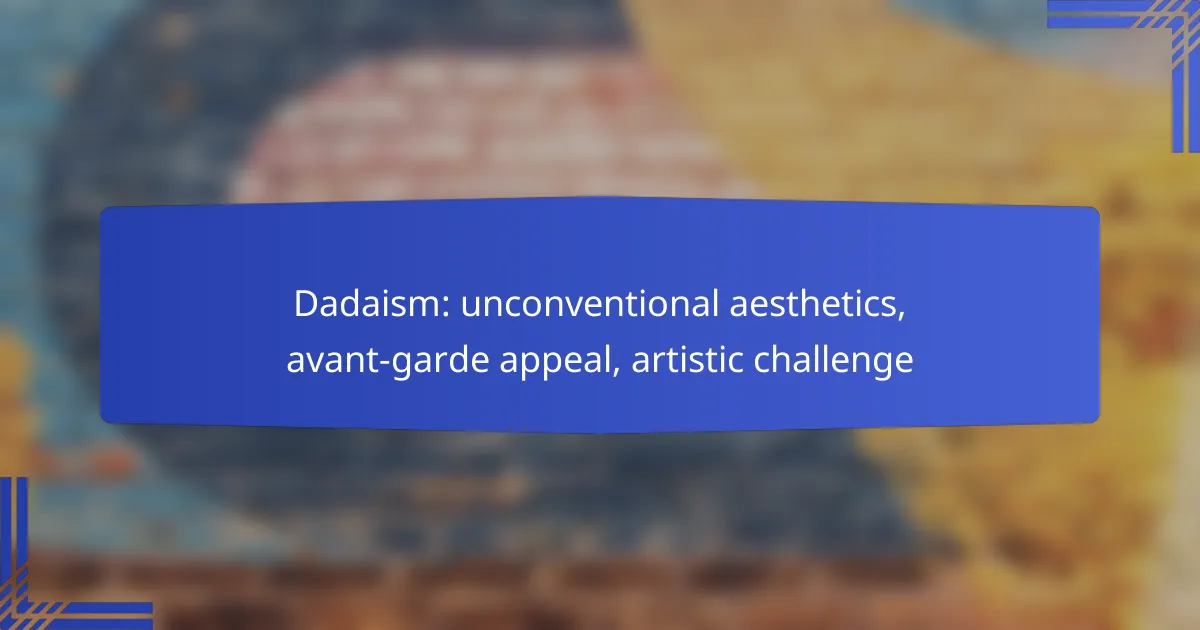Dadaism is an avant-garde movement that fundamentally challenges conventional aesthetics by rejecting traditional artistic values in favor of chaos and irrationality. Embracing absurdity and spontaneity, Dada artists push the boundaries of expression, often blurring the lines between art and anti-art, and inviting viewers to reconsider the very nature of creativity.

How does Dadaism challenge conventional aesthetics?
Dadaism challenges conventional aesthetics by rejecting traditional artistic values and embracing chaos and irrationality. This avant-garde movement promotes a radical departure from established norms, encouraging artists to explore new forms of expression that defy logic and reason.
Subversion of traditional art forms
Dadaism subverts traditional art forms by questioning the very definition of art itself. Artists within this movement often created works that were intentionally provocative, using techniques that disrupted conventional expectations, such as nonsensical imagery and unconventional materials.
For example, Marcel Duchamp’s “Fountain,” a urinal presented as art, exemplifies this subversion. By elevating everyday objects to the status of art, Dadaists challenge viewers to reconsider their perceptions of creativity and artistic merit.
Emphasis on absurdity and randomness
The emphasis on absurdity and randomness is central to Dadaism, as it reflects the chaos of the modern world. Dada artists often employed chance operations, allowing randomness to dictate the outcome of their work, which further distances their creations from traditional artistic intent.
For instance, the use of automatic writing or spontaneous drawing techniques allowed artists to tap into their subconscious, producing works that are often nonsensical yet thought-provoking. This approach encourages audiences to engage with art in a more instinctual and less analytical manner.
Use of found objects and collage
Dadaism prominently features the use of found objects and collage, which are integral to its challenge of conventional aesthetics. By repurposing everyday items, artists create new meanings and contexts, blurring the lines between art and life.
Collage techniques, such as those used by Hannah Höch, combine disparate elements to form a cohesive yet chaotic whole. This method not only critiques societal norms but also invites viewers to find beauty in the unexpected and the discarded.
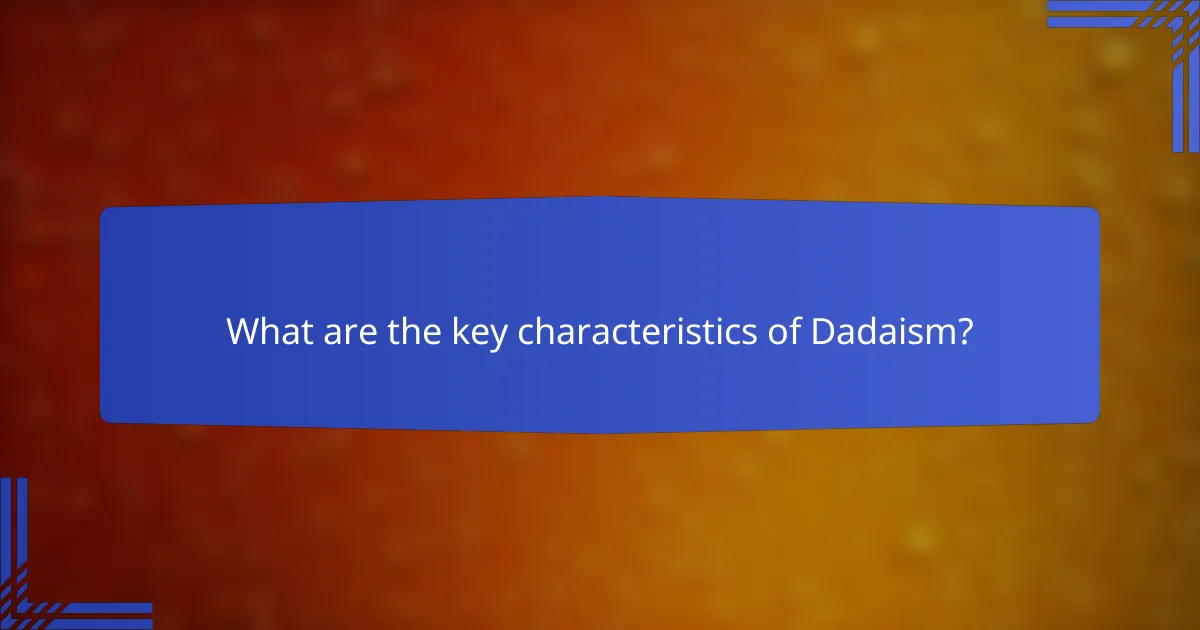
What are the key characteristics of Dadaism?
Dadaism is characterized by its rejection of traditional aesthetics and its embrace of absurdity, chaos, and spontaneity. This avant-garde movement challenges conventional artistic norms, often blurring the lines between art and anti-art.
Anti-art philosophy
The anti-art philosophy of Dadaism posits that art should not adhere to established standards or expectations. Instead, it often seeks to provoke thought and question societal norms through its unconventional forms and themes.
Dada artists like Marcel Duchamp famously used everyday objects, such as his “Fountain,” to challenge the definition of art itself. This approach encourages viewers to reconsider their perceptions of creativity and value in art.
Embracing chaos and spontaneity
Dadaism embraces chaos and spontaneity as essential elements of artistic expression. This movement often celebrates randomness, allowing artists to create works that reflect the unpredictability of life.
Techniques such as automatic drawing, collage, and chance operations are commonly employed, resulting in artworks that can be surprising and thought-provoking. This unpredictability invites audiences to engage with art on a more instinctual level.
Integration of performance and visual arts
Dadaism integrates performance and visual arts, creating a multi-dimensional experience for audiences. This fusion often includes poetry readings, theatrical performances, and visual art displays, all designed to challenge and engage viewers.
Events like Dada soirées featured live performances that combined various art forms, emphasizing the collaborative nature of the movement. This integration highlights the belief that art should be an immersive experience rather than a passive observation.

Which artists are central to the Dada movement?
Key artists central to the Dada movement include Marcel Duchamp, Hannah Höch, and Tristan Tzara. These figures challenged traditional artistic norms and embraced absurdity, creating works that questioned the very nature of art.
Marcel Duchamp
Marcel Duchamp is often regarded as the leading figure of the Dada movement. His most famous work, “Fountain,” a urinal presented as art, exemplifies Dada’s challenge to conventional aesthetics. Duchamp’s use of ready-made objects sparked debates about the definition of art and the role of the artist.
His approach encouraged artists to think critically about the context and presentation of their work, leading to a broader understanding of artistic expression. Duchamp’s influence extends beyond Dada, impacting movements like conceptual art and pop art.
Hannah Höch
Hannah Höch was a pioneering figure in Dada, particularly known for her innovative collage work. She used photomontage to critique societal norms and gender roles, blending images from magazines and newspapers to create powerful visual statements. Her piece “Cut with the Kitchen Knife” is a notable example of her technique and thematic focus.
Höch’s work often addressed issues of feminism and identity, making her contributions vital to both Dada and feminist art movements. Her ability to combine humor and critique remains influential in contemporary art discussions.
Tristan Tzara
Tristan Tzara was a key theorist and poet of the Dada movement, known for his role in defining its principles. He co-founded the Cabaret Voltaire in Zurich, where Dada artists gathered to perform and share their ideas. Tzara’s manifestos emphasized spontaneity and the rejection of logic, encouraging artists to embrace chaos and absurdity.
His poem “To Make a Dadaist Poem” illustrates the movement’s playful approach to language and creativity. Tzara’s emphasis on the irrational continues to resonate, influencing various avant-garde movements and contemporary art practices.
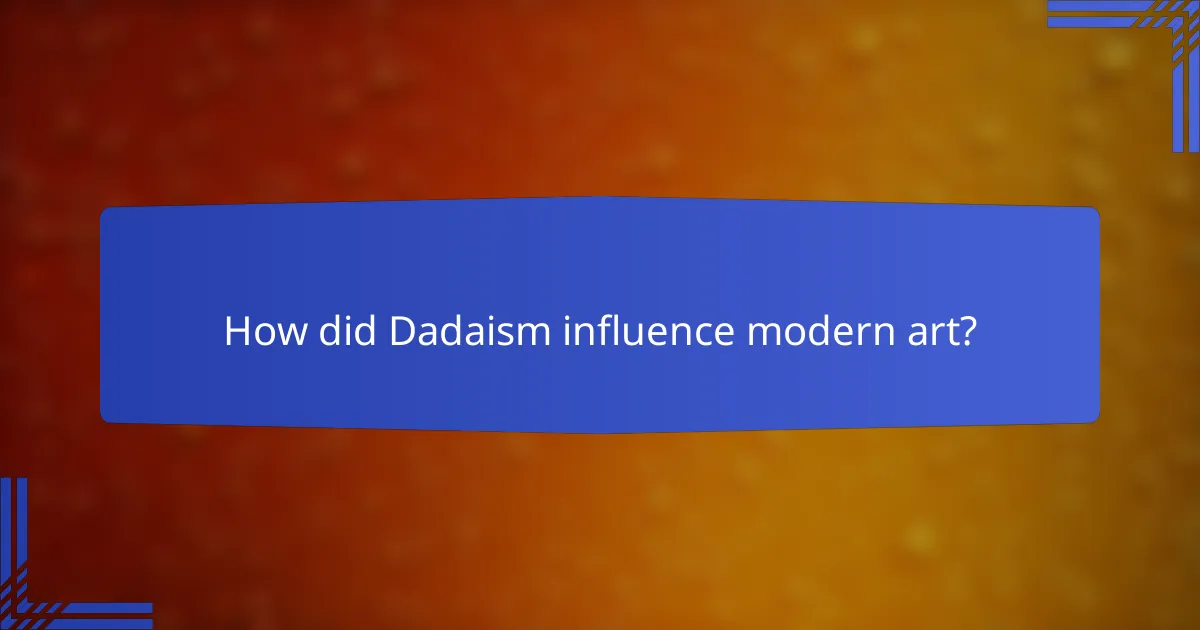
How did Dadaism influence modern art?
Dadaism significantly influenced modern art by challenging traditional aesthetics and embracing absurdity, randomness, and anti-art sentiments. This avant-garde movement laid the groundwork for various contemporary art forms, encouraging artists to explore unconventional methods and ideas.
Foundation for Surrealism
Dadaism served as a crucial foundation for Surrealism by promoting the exploration of the unconscious mind and dream-like imagery. Surrealists adopted Dada’s rejection of logic and reason, pushing boundaries further by integrating psychological elements into their works.
For example, artists like Max Ernst and Salvador Dalí drew inspiration from Dada’s techniques, such as collage and automatic drawing, to create visually striking pieces that challenged viewers’ perceptions of reality.
Impact on contemporary performance art
Dadaism’s emphasis on spontaneity and audience interaction has profoundly impacted contemporary performance art. Artists today often incorporate elements of chance and absurdity, reflecting Dada’s spirit of experimentation.
Performance art pieces may involve audience participation or unexpected actions, blurring the lines between artist and viewer, much like Dadaists did in their provocative performances during the early 20th century.
Inspiration for conceptual art
Dadaism’s focus on ideas over traditional craftsmanship has inspired the conceptual art movement, which prioritizes the concept behind the artwork rather than its aesthetic value. This shift encourages artists to use everyday objects and unconventional materials to convey messages.
For instance, artists like Marcel Duchamp, a key Dada figure, challenged the notion of art by presenting ordinary items as art pieces, paving the way for contemporary artists to explore similar themes in their work.
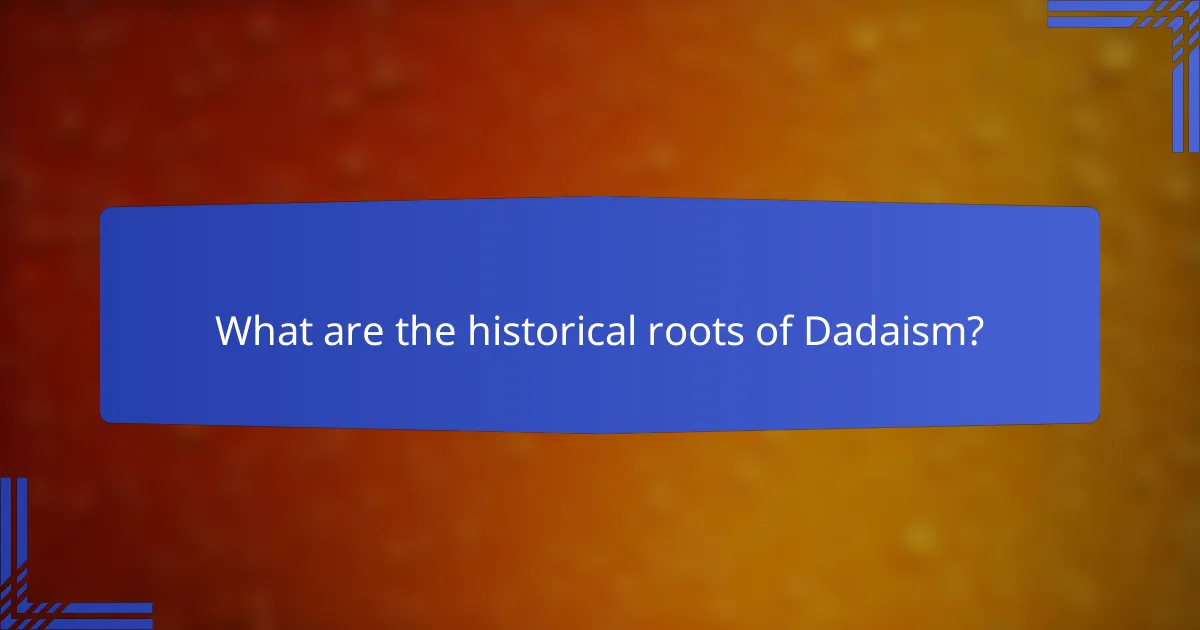
What are the historical roots of Dadaism?
Dadaism emerged as a radical artistic movement in the early 20th century, primarily as a response to the horrors of World War I. It challenged conventional aesthetics and sought to disrupt traditional artistic norms through absurdity and anti-art sentiments.
Origin during World War I
Dadaism originated around 1916, during the height of World War I, as artists and intellectuals sought to express their disillusionment with society and the war. The movement began in Zurich, Switzerland, where a group of artists gathered in a café to create works that rejected logic and embraced chaos.
This period marked a significant shift in the art world, as Dadaists used unconventional materials and techniques to convey their messages, often incorporating found objects and collage into their works.
Development in Zurich and Berlin
The Dada movement quickly spread from Zurich to Berlin, where it gained momentum and attracted a diverse group of artists. In Berlin, Dadaists organized performances, exhibitions, and publications that further challenged the status quo of art and culture.
Key figures such as Hugo Ball and Tristan Tzara in Zurich, and George Grosz and John Heartfield in Berlin, played pivotal roles in shaping the movement. Their works often featured provocative imagery and political commentary, reflecting the tumultuous social climate of the time.
Connection to anti-war sentiment
Dadaism was deeply intertwined with anti-war sentiment, as its creators sought to critique the societal values that led to conflict. The movement’s absurdity was a direct response to the senselessness of war, emphasizing the irrationality of human behavior.
Dada artists used their platforms to promote peace and question authority, often highlighting the futility of nationalism and militarism. This anti-war stance resonated with many, making Dadaism not just an artistic movement but also a significant cultural critique of its era.
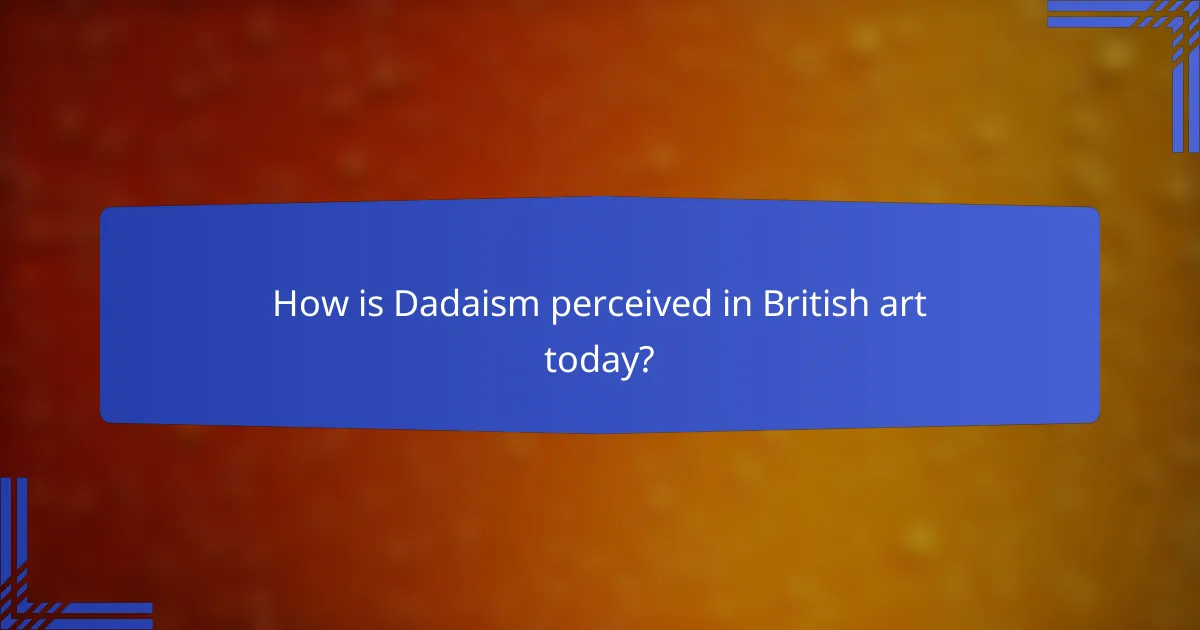
How is Dadaism perceived in British art today?
Dadaism is viewed in British art today as a significant influence that challenges conventional aesthetics and promotes avant-garde expressions. Its legacy continues to inspire contemporary artists who seek to provoke thought and question societal norms through unconventional methods.
Influence on current avant-garde movements
Dadaism has profoundly impacted current avant-garde movements by encouraging artists to embrace absurdity and randomness in their work. This influence is evident in various contemporary art forms, including performance art, installation, and digital media, where traditional boundaries are often blurred.
Many artists today adopt Dadaist principles, using non-traditional materials and techniques to create works that challenge viewers’ perceptions. This approach fosters a spirit of experimentation and innovation, pushing the limits of what art can be.
Exhibitions in major UK galleries
Major UK galleries frequently showcase Dadaism through exhibitions that highlight its historical significance and ongoing relevance. Institutions like the Tate Modern and the Barbican Centre often feature works by Dada artists alongside contemporary pieces that reflect its influence.
These exhibitions not only celebrate Dadaism’s legacy but also engage audiences with interactive installations and performances that echo its core themes. Visitors can expect to see a range of artworks that provoke discussion and reflection on the nature of art and society.
